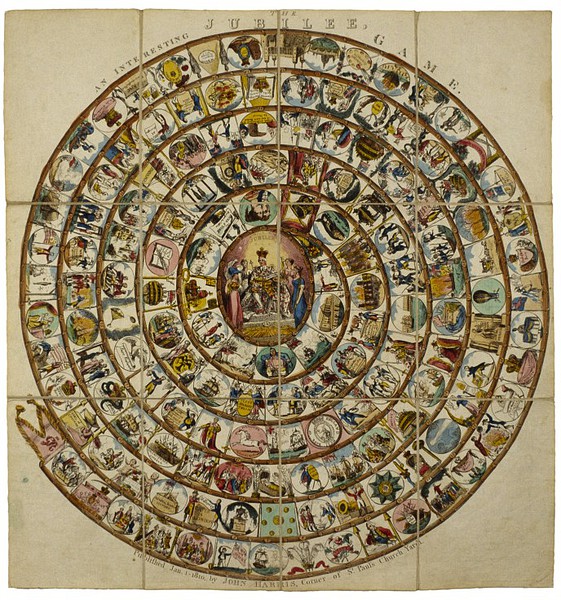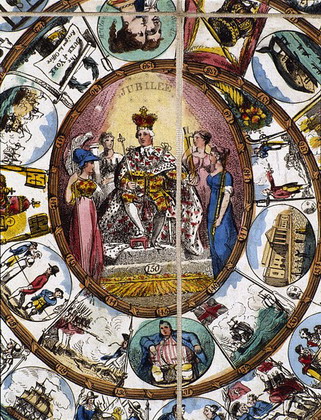Giochi dell'Oca e di percorso
(by Luigi Ciompi & Adrian Seville)
(by Luigi Ciompi & Adrian Seville)

|
Giochi dell'Oca e di percorso
(by Luigi Ciompi & Adrian Seville) |

|
 |

Torna alla ricerca giochi (back to game search) |
 |
| Jubilee (The) | ||
| A New Interesting Game | ||
 |
Versione stampabile
 |
Invia una segnalazione

|
   |
primo autore: | Anonimo |
| secondo autore: | Harris John | |
| anno: | 1810 | |
| luogo: |
Inghilterra-Londra |
|
| periodo: | XIX secolo (1°/4) | |
| percorso: | Percorso di 150 caselle numerate | |
| materiale: | carta incollata su tela (engraving on paper with linen backing) | |
| dimensioni: | 560X532 (554X524) | |
| stampa: | Litografia colorata a mano (hand-coloured engraving) | |
| luogo acquisto: | ||
| data acquisto: | ||
| dimensioni confezione: | ||
| numero caselle: | 150 | |
| categoria: | Personaggi ed eventi storici | |
| tipo di gioco: | Gioco di percorso | |
| editore: | Published Jan. 1 1810 by John Harris, Corner of St Paul's Church Yard | |
| stampatore: | Published Jan. 1 1810 by John Harris, Corner of St Paul's Church Yard | |
| proprietario: | Collezione A. Seville | |
| autore delle foto: | A. Seville | |
| numero di catalogo: | 1373 | |
| descrizione: |
Gioco di 150 caselle, spirale, antiorario, centripeto. REGOLE: non riportate sul tavoliere. CASELLE: mute. REFERENZA 1 "The Jubilee". V&A Museum. This extremely colourful game is a continuation of the Historical Pastime game which charted English history from the Norman Conquest to the accession of George III and this game celebrates his Golden Jubilee. There are 150 playing spaces detailing the major events of the reign of George III. The accompanying booklet, which uses flowery language in praise of the king, does not refrain from describing some of the more disagreeable events. It also includes descriptions of scientific and geographical discoveries. Physical description Design: engraving, coloured by hand; 12 sections of paper mounted on linen N°of squares: 150 Squares illustrated: all Square numbering: 1 to 150 Squares titled: ? Subject of starting square: Proclamation of George III, 1760 Subject of ending square: The Jubilee, September 1809 Place of Origin: London Date: 01/01/1810 Artist/maker: Harris, John Materials and Techniques: Hand-coloured engraved paper on linen Dimensions: Length: 56 cm; width: 53.2 cm Object history note: The booklet contains a brief description of each of the 150 plates and also a more detailed description of the REMARKABLE OCCURRENCES DURING THE REIGN OF HIS PRESENT MAJESTY. SEE ALSO HISTORICAL PASTIMES, and E.467-1949 Historical context note Rewards: receipt of counters and forward movement; also provision if one player lands on an occupied square, the first moves one forward and receives payment Forfeits: payment of counters, and backward movement N°of Players: 6, see rules Equipment required: teetotum, markers and counters, see rules Rules: RULES AND DIRECTIONS FOR PLAYING THE JUBILEE In playing this Game, a teetotum of eight sides is made use of, together with six counters of different colours, as markers, to avoid confusion in telling the game. Each player should also be provided with about two dozen of counters, on which a nominal value should be set, that any player who happens to be out, may purchase of the winners. If more than six persons sit down to play, a greater number of markers may be cut out of card, and distinguished by figures, as may be agreed on. Each player proceeds in the game according to the numbers he spins, and pays the fine, or receives the reward appointed. Advances are made by adding the figure turned to that on which the marker stands. Should any player spin a number on which there is already a marker, he must take its place and the other must move one forward. Any player taking more than his due, must go back as many numbers as he took. If he take too few, and the next player have spun, he must remain where he was. Whatever fines are marked in the list of numbers, must be put into the pool, and the first who makes exactly 150, or `The Jubilee' wins the game; but if he happens to spin above that number, he must go back as may from 150 as he spun beyond it, till he or some one else wins the pool and its contents. Persons going backward in the game are exempted from the fines attached to the figures on which they be obliged to rest. EXAMPLE Suppose John, Thomas and James play the game; James chooses a white marker, Thomas a red and john a green one; James by agreement spins first; and finding the uppermost number of the teetotum to be 2, he places his Marker on the Funeral of George the Second. Thomas spins next, No. 8, and places his mark on the Birth of the Prince of Wales. John next turns No 1 and places his mark on the Proclamation of George the Third. James then plays again, and spins No. 8 which being added to 2, his former number, sends him forward to the Commitment of Wilkes to the Tower, when he is to pay 2 counters to the pool, and go back to No. 1. Thomas spins No. 7 which, added to 8, his former number, brings him to the first meeting of the American Congress. John then spins No. 5, which added to 1, his former number, carries him to the Declaration of War against Spain and pays two counters to the Pool. Again James spins No. 5, which authorises him to take the station occupied by Thomas's mark. Thomas therefore moves to No. 16; and John having spun No. 3 moves to No. 9. The following is in the front of the booklet and while an advertisement is more a praise of the King ADVERTISEMENT This Game may be considered as a Continuation of one published a few years back, entitled HISTORICAL PASTIMES OF ENGLAND, which commenced at the Conquest and ended at the Accession of his present Majesty. where that left off, this begins; and it is hoped that the Events recorded (and surely an eventful Reign it has been) will create a lively interest in the breast of every Juvenile Briton; it is continued to the 25th of October 1809, the day our revered Sovereign entered the Fiftieth year of his Reign, and a Day of Jubilee in every part of his Dominions. The writer of this has only to unite his wishes with those of his fellow subjects, that our good King may long continue to be the Ruler, as he has hitherto been the Father of a free and generous People. *pasted onto the label on the slip case is an additional label with the lettering SOLD BY JOHN WALLIS AT HIS INSTRUCTIVE TOY WAREHOUSE N°13 WARWICK SQUARE (LONDON). *There is a further listing of the events, year by year. The text, which used flowery language in praise of the king, does not refrain from describing some of the more disagreeable events. It also includes descriptions of scientific and geographical discoveries. Rules placement: booklet, H Bryer, Printer, Bridge Street, Blackfriars, London Descriptive line: Hand coloured historical race game, The Jubilee, published in England by John Harris in 1810 Attribution Note: Slipcase -sold by John Wallis at his instructive toy warehouse n°13 Warwick Square Booklet, H. Bryer, Printer, Bridge Street, Blackfriars, London REFERENZA 2 British Museum © The Trustees of the British Museum 1893,0331.122 Title: An Interesting Jubilee Game. Materials: paper Techniques: hand-coloured etching Production person: Published by John Harris Production place: Published in London Date: 1810 Schools /Styles: British Description: Circular game-board with 150 numbered pictorial compartments, each representing an historical event or birth in the reign of George III, commencing with his proclamation and ending with his golden jubilee. Acompanied by a 54 page rule booklet and kept in a board slip-case bearing a printed label. 1810. Hand-coloured etching backed on linen. Inscriptions Inscription Content: Lettered with title at top and publication details at bottom Dimensions: Height: 554 millimetres; width: 524 millimetres Subject: education Associated names: Associated with King George III Acquisition name: Donated by Lady Charlotte Schreiber REFERENZA 3 WHITEHOUSE, Francis Reginald Beaman, (pag. 28): THE JUBILEE An Interesting Game. Published Jan. 1. 1810 by John Harris, Corner of St. Paul’s Church Yard. An engraving size 20 ¼ in X 22 in, hand-coloured, mounted in 12 sections on linen, contained in slip-in case with picture label on front. There are 150 circular panels, terminating in the centre with a picture of George III throned and surrounded by 4 emblematic figures. The illustrations are chiefly representative of events during the 50 years of the king’s reign from 1760 to date of publication. |
|
| bibliografia: |
1) WHITEHAUSE, F.R.B.: "Table Games of Georgian and Victorian Days", London, Peter Garnett, 1951. 2) GOODFELLOW, Caroline: "A Collector's Guide to Games and Puzzles". Secaucus, New Jersey, Chartwell Books-London, Quintet Publishing Limited 1991. 3) GOODFELLOW, Caroline: "The Development of the English Board Game, 1770-1850", in Board Games Studies 1, 1998. 4) GOODFELLOW, Caroline: "Jeux de société. Le guide du collectionneur des jeux de société depuis le XVIIIe siècle jusqu’à nos jours", (Edizione francese) Carrousel MS, 2001. 5) SEVILLE, Adrian: "The Game of Goose: and its influence on cartographical race games" Journal of the International Map Collectors' Society, Winter 2008 N°115 2008. 6) SEVILLE, Adrian: "The geographical Jeux de l'Oie of Europe." In "Belgeo" 2008 3-4 2008. 7) GOODFELLOW, Caroline: "How We Played: Games From Childhood Past", History Press, 2012. 8) QUINN, Brian - CARTWRIGHT, William: "Geographic Board Games". Geospatial Science Research 3. School of Mathematical and Geospatial Science, RMIT University, Australia. December 2014. 9) SEVILLE, Adrian: "The Royal Game of the Goose four hundred years of printed Board Games". Catalogue of an Exhibition at the Grolier Club, February 23 - May 14, 2016. 10) LIMAN, Ellen: "Georgian and Victorian Board Games: The Liman Collection", Pointed Leaf Press, 2017. 11) NORCIA, Megan A.: "Gaming Empire in Children's British Board Games, 1836-1860". Studies in Childhood, 1700 to the Present. Routledge, 2019. 12) SEVILLE, Adrian: "L'arte dei giochi da tavolo. Oltre un secolo di storia e divertimento dalla fine del Settecento all'inizio del Novecento." Edizioni White Star, 2019. 13) PARLAK, Omer Fatih: "Seafearing through the Perspective of Historic Board Games", in DGSM, Köllen Druck+Verlag, Bonn 2020. |
|
| "The Development of the English Board Game, 1770-1850" (Caroline G. Goodfellow) | ||
| Historical Games. "Table Games of Georgian and Victorian Days". (Francis Reginald Beaman, Whitehause) | ||
Vai alla ricerca giochi Vai all'elenco autori